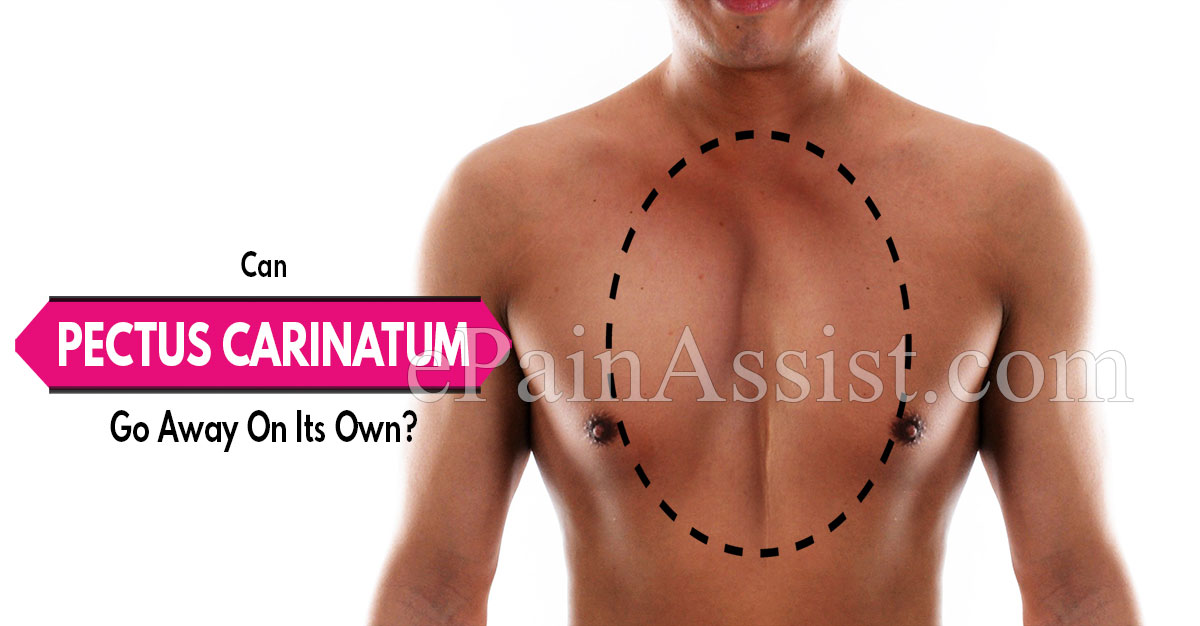Pectus carinatum is a long-term cosmetic disorder that will not go on its own, but it is not dangerous by itself.1
Pectus does not produce any symptoms despite the abnormal appearance of the chest.2
Surgery and braces are the most available treatment for pectus carinatum to improve self-esteem and quality of life.3,4

Can Pectus Carinatum Go Away On Its Own?
Pectus carinatum is one of the most common chest wall abnormalities noticed in children. Clinical studies yet to find a definite cause for this condition.
The condition unlikely to get resolved by itself however in mild abnormalities weightlifting and simple exercises can help to bring back the shape to the original. Exercises can help build healthy muscles and mask the shape of the protruding sternum and ribs. Although some conditions of pectus carinatum require surgery to correct the problem most children with this condition will only require an orthotic brace.1
Braces are often helpful in correcting the shape of the chest wall. Wearing braces will compress or squeeze the overgrown ribs. But the bring back procedure is not instantaneous and can take many months. This is a long-term condition that will not resolve on its own, but the affected individual will stop growing after adolescence.
The protrusion appears primarily in two ways:
Upper And Lower Parts Protrusion Of The Chest – This is a less common type that makes the chest look like a “z” shape when you notice from the sides.
Middle And Lower Parts Of The Chest Plate Protrusion – This is the most common condition occurring in 95 percent of cases with pectus carinatum.
But several studies claim that the symptoms are not serious other than creating the abnormal appearance of your sternum. But conditions that are left untreated can make you sick and shorten your lifespan.2
What Are The Natural Remedies For Pectus Carinatum?
Pectus carinatum is classified into two types based on the time of onset and depending on the cause.
Post-Surgical – The condition occurs when the breastbone doesn’t come back to the original posture after surgery
Congenital – This is typically a birth defect due to the premature fusion of the chest ribs
Idiopathic – They are the most common anomalies that occur during the growth spurt in children aged between 11 and 15 years.
Although braces and surgery are the most common type of treatment yet in recent years people have begun experimenting with exercises. Medical studies are trying to find pieces of evidence to demonstrate that exercise is a potential treatment for treating pectus carinatum. They are key components for the treatment that can help to strengthen your chest, back, and core muscles. This can also aid in stretching your chest cavity.3, 4
But medical treatmentshave a good prognosis in children compared to adults with low morbidity. Braces and surgery in young children require a shorter hospital stay with very good cosmetic results.
Pectus Carinatum is a deformity of the chest believed to be caused by factors including abnormal growth of cartilages and breast bones in the chest. Also, genetic conditions can also cause abnormality in bone and muscle growth.
Protrusion of the chest bone is the primary symptom of pectus carinatum causing pain and difficulty breathing when the ribs push the anterior chest. People with pectus rectum especially children experience a disturbed body image and lead a reduced quality of life.
- Tom Liu, MD. “Pectus Carinatum: Treatment & Symptoms in Kids over Time.” Buoy, 6 Jan. 2021, www.buoyhealth.com/learn/pectus-carinatum
- Fonkalsrud, Eric W, et al. “Repair of Pectus Excavatum and Carinatum Deformities in 116 Adults.” Annals of Surgery, U.S. National Library of Medicine, Sept. 2002, www.ncbi.nlm.nih.gov/pmc/articles/PMC1422584/.
- Martinez-Ferro, Marcelo, et al. “Non-Surgical Treatment of Pectus Carinatum with the FMF® Dynamic Compressor System.” Journal of Visualized Surgery, AME Publishing Company, 17 Mar. 2016, www.ncbi.nlm.nih.gov/pmc/articles/PMC5638266/.
- Hyperarts, Rob Mayfield -. “Pectus Carinatum.” Department of Surgery – Pectus Carinatum, https://surgery.ucsf.edu/conditions–procedures/pectus-carinatum.aspx
Also Read:
